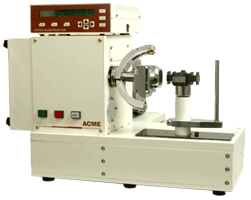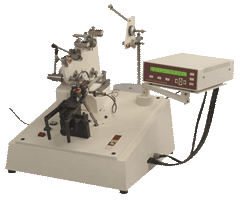These days, the winding machines have higher demands because of the products that are manufactured by using these machines. There are three major electronic components, namely inductors, capacitors and resistors. Without these components, it is just impossible to build even a single electronics circuit. The inductors are mainly manufactured by the winding machine and therefore the winding machine has a vital role to play for the products that involve electronics control. So, the inductors are nothing but the coils.
Winding machine types: On the basis of coil design, different types of winding machines are classified. There are mainly three main types of winding machines, which include: toroidal winding machines, linear winding machines and flyer winding machines. Other winding machines are basically the combination of these three winding machine types to obtain specific winding jobs. Now, it is important to get information on different types of winding machines one by one. In this write up, you will get information about the linear winding machines and other types will be discussed in the next articles.
Linear winding machine: This is the most extensively used winding machine or it can be said that around 70% of the winding machines used across the globe are linear winding machines. The main function of this machine is to wind the air of any rotating object that can be simple core, bobbin or metal part. In this type of winding machine, there are mainly two fundamental functions. The first thing is to spin the bobbin and the next is to guide the wires within the available bobbin space. So, the linear winding machine contains spindle to rotate the bobbin and therefore the traverse unit for spreading the wire within bobbin. In most of the cases, the linear winding machines contain only spindle assembly and this wire is allowed to spread on its own or even directed by the operator. Then why the traverse mechanism is offered in these linear winding machines. Two main reasons are there why the traverse mechanism is offered in these machines. One of the reasons is to obtain automated winding procedure and other one is to have high density turnings within the space available in the bobbin. It is actually necessary to wind the turns in the smallest area possible in the electric coils. The maximum amount of electrical magnetic field is created while more turns are wound in limited area. The magnetic area will never spread and therefore the density of the magnetic field would be high. Here comes the picture of linear winding machine with traverse unit and spindle assembly.
Winding machine types: On the basis of coil design, different types of winding machines are classified. There are mainly three main types of winding machines, which include: toroidal winding machines, linear winding machines and flyer winding machines. Other winding machines are basically the combination of these three winding machine types to obtain specific winding jobs. Now, it is important to get information on different types of winding machines one by one. In this write up, you will get information about the linear winding machines and other types will be discussed in the next articles.
Linear winding machine: This is the most extensively used winding machine or it can be said that around 70% of the winding machines used across the globe are linear winding machines. The main function of this machine is to wind the air of any rotating object that can be simple core, bobbin or metal part. In this type of winding machine, there are mainly two fundamental functions. The first thing is to spin the bobbin and the next is to guide the wires within the available bobbin space. So, the linear winding machine contains spindle to rotate the bobbin and therefore the traverse unit for spreading the wire within bobbin. In most of the cases, the linear winding machines contain only spindle assembly and this wire is allowed to spread on its own or even directed by the operator. Then why the traverse mechanism is offered in these linear winding machines. Two main reasons are there why the traverse mechanism is offered in these machines. One of the reasons is to obtain automated winding procedure and other one is to have high density turnings within the space available in the bobbin. It is actually necessary to wind the turns in the smallest area possible in the electric coils. The maximum amount of electrical magnetic field is created while more turns are wound in limited area. The magnetic area will never spread and therefore the density of the magnetic field would be high. Here comes the picture of linear winding machine with traverse unit and spindle assembly.
Here the bobbin is mounted and the wire guide is also mounted on the traverse unit for moving the wire. So, the machine is either designed with the mechanical control or with the electronic control of the traverse movement. In the earlier time, winding machines used to exist with the mechanical control but these days, machines with electronics control are mainly preferred because of high level of control and better performance. Also some extra features can be added in the electronics controlled traverse unit.
The control of spindle in these machines is quite simple that starts with the rotation of bobbin while stopping the bobbin rotation and controlling the rotation direction. Except this, no more control feature is needed for rotating the spindle in any winding machine. The accuracy of stopping is considered as one and only vital aspect to count on while it comes to choosing the winding machine. Undoubtedly slow stop and slow start is necessary to avoid braking of the wire.
The traverse unit is considered to be the most complicated control included in any winding machine. This unit needs to follow the spindle rotation function. Some of the present time functions include the starting positions of these winding turns along with the traverse stopping position, returning of the unit at the end of the width of bobbin, rate of wire spreading during winding over the length of bobbin and many more.
The main controlling parameters while it comes to choosing the winding machine are:
- Programmable slow start with regard to turns
- Programmable slow stop with regard to turns
- Winding speed
- The spindle rotation direction
- Position of traverse starting
- Pitch control
- Width of traverse
Apart from the above parameters, there are some other parameters that should be considered but these are secondary parameters while it comes to choosing the winding machines. Acme Electronics is one company that manufactures winding machines with all the basic parameters mentioned above along with other secondary controls meant for coils.
In the next articles, we will talk more about other two winding machine types available namely Flyer winding machine and Toroidal winding machine.

